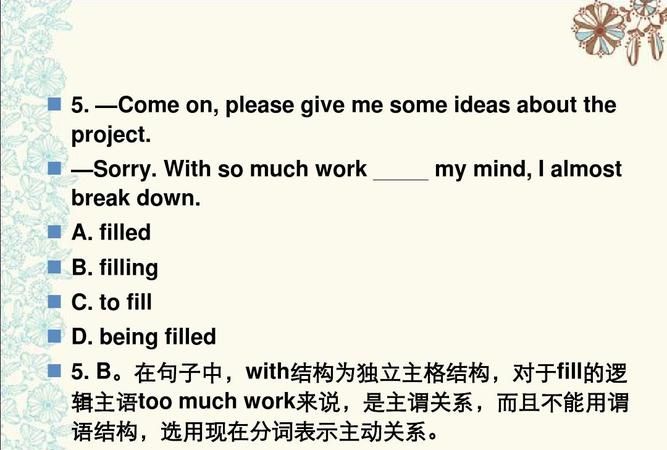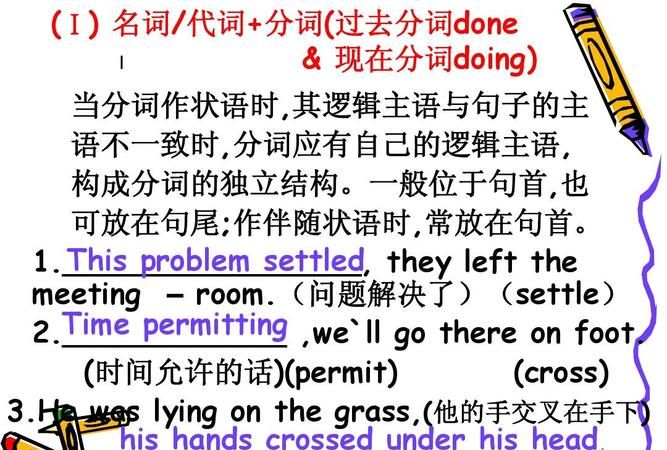本文目录
英语中的n.v.adj.adv.分别代表什么?
首先,这个问题应该是:with 的复合结构与独立主格结构的区别是什么?with+复合结构:with+宾语+宾语补足语(相当于名词、形容词或者副词的词或者短语)With everything done, we feel quite relaxed.The teacher rushed in, with a strange book under his arm.独主格结构:逻辑主语+相当于名词、形容词或者副词的词或者短语.以上两句可以改成:Everything done, we feel quite relaxed.The teacher rushed in, a strange book under his arm.说明:不是每个句子都可以在两者之间转换的.总体讲,独立主格结构更简洁,常常可以省掉一些无关紧要的词,如,所有格、冠词等.如:He ran after the robber, with a club in his hand.He ran after the robber, club in hand.具体区别还要看具体的情景和句子.常见的选择题中的选项,比如:with club in hand是错项,因为在with结构中a和his不能省略.

with复合结构是什么意思
答:with的复合结构,是由with+复合宾语组成。常在句中做状语,表示谓语动作发生的伴随情况、时间、原因、方式等。其构成有下列几种情形:
1.with+名词(或代词)+现在分词
此时,现在分词和前面的名词或代词是逻辑上的主谓关系。
例如:1)With prices going up so fast, we can't afford luxuries.
由于物价上涨很快,我们买不起高档商品。(原因状语)
2)With the crowds cheering, they drove to the palace.
在人群的欢呼声中,他们驱车来到皇宫。(伴随情况)
2.with+名词(或代词)+过去分词
此时,过去分词和前面的名词或代词是逻辑上的动宾关系。
例如:1)I sat in my room for a few minutes with my eyes fixed on the ceiling.
我在房间坐了一会儿,眼睛盯着天花板。(伴随情况)
2)She had to walk home with her bike stolen.
自行车被偷,她只好步行回家。(原因状语)
3.with+名词(或代词)+形容词
例如:1)I like to sleep with the windows open.
我喜欢把窗户开着睡觉。(伴随情况)
2)With the weather so close and stuffy, ten to one it'll rain presently.
大气这样闷,十之八九要下雨。(原因状语)
4.with+名词(或代词)+介词短语
例如:1)With the children at school, we can't take our vacation when we want to.
由于孩子们在上学,所以当我们想度假时而不能去度假。(原因状语)
2)The soldier had him stand with his back to his father.
士兵让他背朝着他的父亲站在那儿。(行为方式)
5.with+名词(或代词)+副词
例如:1)He fell asleep with the light on.
他睡着了,灯还亮着。(伴随情况)
2)The boy stood there with his head down.
这个男孩低头站在那儿。(伴随情况)
6.with+名词(或代词)+动词不定式
此时,不定式表示将发生的动作。
例如:1)With no one to talk to, John felt miserable.
由于没人可以说话的人,约翰感到很悲哀。(原因状语)
2)With a lot of work to do, he wasn't allowed to go out.
因为还有很多工作要做,他没有被允许外出。(原因状语)

with引导独立主格结构状语
with后面是独立主格结构。
现在分词可有其独立的逻辑主语。这种主语常常是名词或代词主格,置于现在分词之前,二者构成一种分词独立结构。现在分词独立结构常用作状语,置于句首或句末,偶尔也置于句中。现在分词独立结构多用在书面语中。
1)表时间。如:
(1)The dark clouds having dispersed, the sun shone again. 乌云已散去,太阳又普照大地了。
(2)The question being settled, we went home. 问题解决之后,我们就回家了。
2)表原因。如:
(3)The monitor being ill we’d better put the meeting off. 班长病了,我们最好还是延期开会吧。
(4)The river having risen in the night, the crossing was impossible. 夜里河水上涨,渡河不可能了。
3)表条件。如:
(5)Weather permitting, we’ll have the match tomorrow. 天气允许的话,我们将于明天进行比赛。
(6)Other things being equal, I would buy the black dress not the white one. 其它方面如皆相同,我将买那件黑的衣服,不买那件白的。
4)表方式或伴随情况。如:
(7)Their room was on the third floor, it’s window overlooking the sports ground. 他们的房间在三层楼上,窗户俯视着操场。
(8)He guiding her, they stumbled through the street. 他引着她,两个人蹒跚穿过那条街。
(9)He, God willing, would be in the village before the second next month. 他,如果情况允许,将于下月2日前来到这个村庄。
有时这种现在分词独立结构具有一种解释性的功能。如:
(10)We redoubled our efforts, each man working like two. 我们加倍努力,每一个人就像于两个人的话。
(11)Only three fissile materials are known at present, these being uranium-235, uranium-233 and plutonium. 现在只知道三种可裂变物质,即铀-235,铀-233和钚。
现在分词独立结构之前可用介词with。介词with在此没有什么意义,只是比较口语化。如:
(12)With Mr. Ade taking the lead, they decided to set up a trading company. 以艾德先生为首,他们决定成立一个贸易公司。(用作方式状语)
(13)We went into a large waiting room with a large fan spinning overhead. 我们走进一个大候诊室,头上有一个大电扇运转着。(用作定语)
(14)With the whole meeting in uproar, the chairman abandoned the attempt to take a vote. 整个会议吵作一团,于是主席放弃了投票的企图。(用作原因状语)
希望我能帮助你解疑释惑。

with复合结构和独立主格是一回事吗
独立主格结构:形容词&副词&介词短语&状语从句&非谓语动词充当状语,在句中可以表示时间、原因、条件、方式或伴随情况等.
结构:名词/代词 + 非谓语(doing & todo & done)
形容词&副词
介词短语
with和without复合结构是: with/without+名词/代词+分词/不定式/形容词/副词/介词短语.在句子中可以作状语或定语.
with/without+名词/代词+不定式.用不定式表示将要发生的动作.
with/without+名词/代词+形容词.
with/without+名词/代词+副词.
with/without+名词/代词+介词短语.
with和without复合结构可以作后置定语修饰名词,而独立主格结\x0b构则不可作后置定语修饰名词.

以上就是关于with复合结构是独立主格 ,英语中的n.v.adj.adv.分别代表什么?的全部内容,以及with复合结构是独立主格吗 的相关内容,希望能够帮到您。
